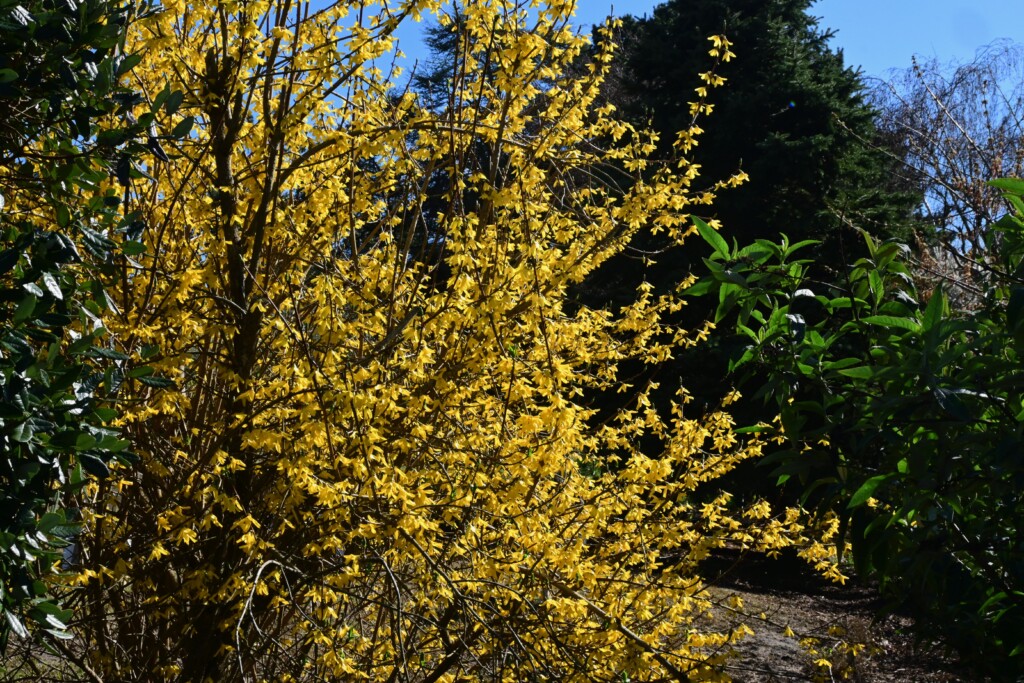I remember turning up in London, for my first time, in April 1991, and the only things in flower in the otherwise bare front gardens as I was driven from the airport were Viburnum tinus and Forsythia. I saw both of them with new eyes, that day.
I’d always loved Forsythia (less so the Viburnum, but read more about that here), but on that gloomy, low-cloud day, they looked as if they had their own independent source of illumination.
Forsythia is in flower now, for us, at about the same time as most of the wattles. And I can’t help but wonder if it’s sheer snobbery that I get more pleasure from the former than from the latter. Guaranteed those Londoners wouldn’t see it the same way, if they could have both. But in my own defence (against my own attack – see how my brain works?) I do think there’s something particularly captivating about those deciduous shrubs that flower before their leaves appear. Add to that my penchant for anything with hanging, bell-like flowers, and I’d argue that the result is virtually irresistible.

It’s surprising, then, that I don’t consider Forsythias as front-runners in the shrub category. Please fight me on this if you disagree! To me their perfect place is the hedgerow, or along the front boundary (of a big property), or deep in the back of a very deep shrubbery. That’s probably because they’re total passengers for the entire rest of the year, making no contribution in the form of good foliage, or seed heads or any such thing.
Forsythias are classic cane-growing shrubs, meaning that rather than slowly accumulating bulk by growing from the tips, strong new canes branch off old ones from deep inside the shrub, so pruning entails the removal of old canes right back to that branching point, rather than a peripheral trim. The result is (at best) a rather charming vase shape of about 3m x 3m, with long fingers stretching out horizontally, so that the floral density just diffuses at the extremities. Plants of this form should never be trimmed over into a predetermined shape (with the single exception of Simon Rickard’s excellent suggestion regarding Ribes sanguineum. Admittedly it’s not as emphatically cane-growing as Forsythia, but is sufficiently so to make his exception notable. Check it out here). It’s at odds with their very nature.

I remember the great Dan Hinkley once stating, perhaps slightly tongue-in-cheek, and in total contradiction to my point above, that in his home town in Michigan it was so cold that they grew Forsythia as a foliage plant only. It was too cold for it, or many other shrubs for that matter, to flower! It makes you realise how spoilt for choice we are, here.
Hmm that’s a hard choice for me, Michael as I have strong and happy memories of both. ( Isn’t that half of why we choose plants for our gardens?)
But I would always plant forsythia ahead of a wattle because I am addicted to as much seasonal change as I can get in my garden. The changing look of it all, the sideways light coming through, the freshness of spring, all are necessary for me. Oh, and what treasures one can grow underneath deciduous trees and shrubs!
Some of these will die back and don’t even need care over summer, without leaving a gap in the garden since the shrub (in this case) will have leafed out.
Of course Forsythia will be sturdy enough for a lightweight vine or perennial to clamber into it at some point in the growing season…. You get where I am going with this.
That’s a great idea. It’d perfect to train one of those minimal-vigour or non-climbing clematises into. Like my Clematis x durandii, or C. ‘Rooguchi’
Interesting question Michael. Being English, one might think I’d choose the Forsythia without much thought; however, on reading your question I immediatley found myself voting for a Wattle.
I planted a Forsythia in my garden atleast 25 years ago as it was a shrub I remembered fondly from my childhood in southern England. I was for many years very proud of my Forsythia and the fact that it seemed nobody else had one, and most had not even heard of it. Over the years however, I have found it difficult to contain and even though I am now much more proficient in cutting out canes altogether, I am disappointed in its flowering density. This does vary from one year to the next, and although this year is better than the last few, I remain underwhlemed.
A few weeks ago I spotted a most graceful and elegant wattle, much the same size, in my neighbours garden and thought how much more beautiful it was than my Forsythia. It had a gentle and graceful appearance so superior in my eyes to my slightly angular, gauky and spiky Forsythia. And I do love those little spheres of yellow pipe cleaner. My neighbours Wattle is one of my favourites – indigenous to my area – Acacia acinacea.
Exactly the kind of reassessments I’m forever facing, Jacqui. There’s an Acacia verticillata on the roadside near here with the most wonderful elegant vase shape, and those heavenly lemon-yellow flowers. I keep imagining growing lots of it, but am reluctant to release all those garden-glove puncturing spines into the garden. But I’m now determined to get hold of Acacia acinacea in numbers. There are far too few in that mid-sized shrub category.